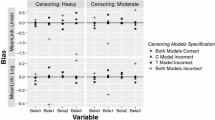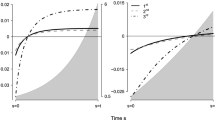Abstract
In biomedical studies where the event of interest is recurrent (e.g., hospitalization), it is often the case that the recurrent event sequence is subject to being stopped by a terminating event (e.g., death). In comparing treatment options, the marginal recurrent event mean is frequently of interest. One major complication in the recurrent/terminal event setting is that censoring times are not known for subjects observed to die, which renders standard risk set based methods of estimation inapplicable. We propose two semiparametric methods for estimating the difference or ratio of treatment-specific marginal mean numbers of events. The first method involves imputing unobserved censoring times, while the second methods uses inverse probability of censoring weighting. In each case, imbalances in the treatment-specific covariate distributions are adjusted out through inverse probability of treatment weighting. After the imputation and/or weighting, the treatment-specific means (then their difference or ratio) are estimated nonparametrically. Large-sample properties are derived for each of the proposed estimators, with finite sample properties assessed through simulation. The proposed methods are applied to kidney transplant data.
Similar content being viewed by others
References
Andersen PK, Borgan O, Gill RD, Keiding N (1993) Statistical models based on counting processes. Springer, New York
Andersen PK, Gill RD (1982) Cox’s regression model for counting processes: a large sample study. Ann Stat 10: 1100–1120
Anstrom KJ, Tsiatis AA (2001) Utilizing propensity scores to estimate causal treatment effects with censored time-lagged data. Biometrics 57: 1207–1218
Bilias Y, Gu M, Ying Z (1997) Towards a general asymptotic theory for the Cox model with staggered entry. Ann Stat 25: 662–682
Cook RJ, Lawless JF (1997) Marginal analysis of recurrent events and a terminating event. Stat Med 16: 911–924
Cook RJ, Lawless JF (2007) The analysis of recurrent event data. Springer, New York
Cook RJ, Lawless JF, Lakhal-Chaieb L, Lee K-A (2009) Robust estimation of mean functions and treatment effects for recurrent events under event-dependent censoring and termination: application to skeletal complications in cancer metastatic to bone. J Am Stat Assoc 104: 6075
Cox DR (1972) Regression models and life-tables. J Roy Stat Soc B 34: 187–202
Fleming TR, Harrington DP (1991) Counting processes and survival analysis. Wiley, New York
Ghosh D, Lin DY (2000) Nonparametric analysis of recurrent events and death. Biometrics 56: 554–562
Ghosh D, Lin DY (2002) Marginal regression models for recurrent and terminal event. Stat Sinica 12: 663–688
Hernan MA, Brumback B, Robins JM (2000) Marginal structural models to estimate the causal effect of Zidovudine on the survival of HIV-positive men. Epidemiology 11: 561–570
Huang CY, Wang MC (2004) Joint modeling and estimation for recurrent event processes and failure time data. J Am Stat Assoc 99: 1153–1165
Lawless JF, Nadeau C (1995) Some simple robust methods for the analysis of recurrent events. Technometrics 37: 158–168
Li Q, Lagakos S (1997) Use of the Wei-Lin-Weissfeld method for the analysis of a recurring and a terminating event. Stat Med 16: 925–940
Lin DY, Wei LJ, Yang I, Ying Z (2000) Semiparametric regression for the mean and rate functions of recurrent events. J Roy Stat Soc B 62: 711–730
Little RJA, Rubin DB (2002) Statistical analysis with missing data. Wiley, New York
Liu L, Wolfe RA, Huang X (2004) Shared frailty models for recurrent events and a terminal event. Biometrics 60: 747–756
Lu K, Tsiatis AA (2001) Multiple imputation methods for estimating regression coefficients in proportional hazards models with missing cause of failure. Biometrics 57: 1191–1197
Lunceford JK, Davidian M (2004) Stratification and weighting via the propensity score in estimation of causal treatment effects: a comparative study. Stat Med 23: 2937–2960
Pan Q, Schaubel DE (2009) Flexible estimation of differences in treatment-specific recurrent event means in the presence of a terminating event. Biometrics (in press)
Pepe M, Cai J (1993) Some graphical displays and marginal regression analysis for recurrent failure times and time dependent covariates. J Am Stat Assoc 88: 811–820
Pollard D (1990) Empirical processes: theory and applications. Institute of Mathematical Statistics, Hayward
Port FK, Bragg-Gresham JL, Metzger RA, Dykstra DM, Gillespie BW, Young EW, Delmonico FL, Wynn JJ, Merion RM, Wolfe RA, Held PJ (2002) Donor characteristics associated with reduced graft survival: an approach to expanding the pool of donor kidneys. Transplantation 74: 1281–1286
Prentice R L, Williams B, Peterson AV (1981) On the regression analysis of multivariate failure time data. Biometrika 68: 373–379
Robins JM (1993) Information recovery and bias adjustment in proportional hazards regression analysis of randomized trials using surrogate markers. In: Proceedings of the Biopharmaceutical Section, American Statistical Association, Alexandria, VA, pp 24–33
Robins JM, Hernan MA, Brumback B (2000) Marginal structural models and causal inference in epidemiology. Epidemiology 11: 550–560
Robins JM, Rotnitzky A (1992) Recovery of information and adjustment for dependent censoring using surrogate markers. In: Jewell N, Dietz K, Farewell V (eds) AIDS epidemiolgy-methodological issues, proceedings of the biopharmaceutical section, American Statistical Association, Alexandria, VA, pp 24–33
Robins JM, Wang N (2000) Inference for imputation estimators. Biometrika 87: 113–124
Rosenbaum PR, Rubin DB (1983) The central role of the propensity score in observational studies for causal effects. Biometrika 70: 41–55
Rubin DB (1978) Bayesian inference for causal effects: the role of randomization. Ann Stat 6: 34–58
Rubin DB (1987) Multiple imputation for nonresponse in surveys. Wiley, New York
Schaubel DE, Cai J (2006) Multiple imputation methods for recurrent event data with missing event category. Can J Stat 34: 677–692
Schaubel DE, Zeng D, Cai J (2006) A semiparametric additive rates model for recurrent event data. Lifetime Data Anal 12: 389–406
Taylor JMG, Marray S, Hsu C-H (2002) Survival estimation and testing via multiple imputation. Stat Probab Lett 3: 221–232
van der Vaart AW (2000) Asymptotic statistics. Cambridge, Melbourne
van der Vaart AW, Wellner JA (1996) Weak convergence and empirical processes. Springer, New York
Wang N, Robins JM (1998) Large-sample theory for parametric multiple imputation estimators. Biometrika 85: 935–948
Wei G (2008) Semiparametric methods for estimating cumulative treatment effects in the presence of non-proportional hazards and dependent censoring. Ph.D Dissertation, Department of Biostatistics, University of Michigan
Wei LJ, Lin DY, Weissfeld L (1989) Regression analysis of multivariate incomplete failure time data by modelling marginal distributions. J Am Stat Assoc 84: 1065–1073
Ye Y, Kalbfleisch JD, Schaubel DE (2007) Semiparametric analysis of correlated recurrent and terminal events. Biometrics 63: 78–87
Author information
Authors and Affiliations
Corresponding author
Rights and permissions
About this article
Cite this article
Schaubel, D.E., Zhang, M. Estimating treatment effects on the marginal recurrent event mean in the presence of a terminating event. Lifetime Data Anal 16, 451–477 (2010). https://doi.org/10.1007/s10985-009-9149-x
Received:
Accepted:
Published:
Issue Date:
DOI: https://doi.org/10.1007/s10985-009-9149-x




